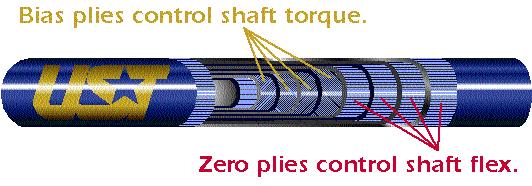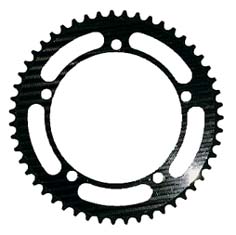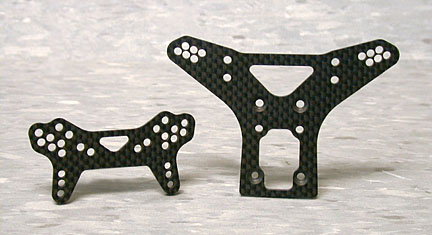Some Uses Of Carbon Fibre
|
USES
|
Some Uses Of Carbon Fibre
This section of my web page looks at some of the areas in which carbon fibre has become a benchmark material compared to other materials.
Formula 1
And other motorsport
An obvious requirement of any high performance racing car, motorbike or powerboat construction is that it should be strong and lightweight. For these reasons, carbon fibre has become acknowledged as the best material for the job. Formula One cars are some of the most expensive pieces of sporting equipment and as a result, a huge amount of money and research has been put into the development of safety and performance of various materials and composites over the years. The modern formula one car is based around a central monocoque which protects the driver and acts as a connecting point to the other components of the car. This part of the car is composed virtually entirely of carbon fibre as it is lightweight (the entire bare chassis weighs just 35kg!) and provides extreme protection against the phenomenal forces involved in the sport due to its high torsional rigidity and high tensile strength. In addition to this, carbon fibre is flame and corrosion proof and, when properly used, shatters in an accident thereby absorbing a huge amount of energy, which would otherwise be transferred directly to the driver. The accident below occurred in the Belgian Grand Prix in 1998, involving a large number of the 22 cars competing, yet every driver walked away, which underlines carbon fibres place in motorsport.
Image from http://www.chequered-flag.org - used without
permission
Many other components of the car are also made from carbon fibre, from the suspension to the gearbox and even the brakes, where carbon fibre has taken over from more traditional materials such as steel, again because it is light weight and that the latest carbon fibre brakes can produce phenomenal stopping power. The manufacture of components is very laborious, involving many stages such as autoclaving, vacuuming and curing and even the smallest components may require 100's of man hours to construct. More details can be found at http://www.euroav.com/Pages/carbon1.html .
Over the years, the use of carbon fibre as the main structural material in the sport has filtered through the various varieties of motorsport and is now found even at the most basic levels and is now becoming increasingly used in the construction of road cars.
Many sports utilise the physical properties of carbon fibre (often referred to as graphite by manufacturers and retailers) as rival companies constantly compete to produce high performance equipment. For example in golf, the traditional materials such as steel used for the shaft of a golf club are being replaced in favour of carbon fibre as it produces a lightweight club, with the advantage of low torque. The diagram below shows how the shaft is constructed. The Bias Plies are layers of carbon fibre which control torque across the lateral axis of the shaft in order to produce torsional rigidity. The zero plies determine the flex of the shaft. Different thickness' and grades of carbon fibre can be used to customise flex in the club.

Image from http://www.ustgolfshaft.com
Used without permission
Tennis is another sport where the same technology is being used to create light, strong rackets. the basic racket is constantly being tweaked by manufactures in the search for maneuverability and power. Carbon fibre is also being used in equipment such as bicycles, where it is used as a lightweight alternative to materials such as aluminium (twice as heavy). These components, such as the one shown below also make use of carbon fibres rigidity, strength and its resistance to stretching. Products such as the chain ring shown below effectively reduce the rotating mass of the ring, thereby increasing efficiency.
Images show Brake Booster (l) and Chain Ring (r). Both are Fibre Lyte Products.
Images from http://www.fibre-lyte.co.uk/fl/fl_cycles.html Used without permissionAnother area where carbon fibre is being used is in the construction of yacht masts. Again it is strong and light, but is also flexible and will always return to its original shape and is extremely unlikely to suffer structural failure. This LUSAS Composite case study provides some more detail on exact technicalities.
Radio Controlled Cars / Models
Following on from the previous examples, carbon fibre is even finding uses in radio controlled model cars and other models. Again, its properties allow sturdy, lightweight chassis and other components to be made to enhance performance

Images from www.hpiracing.com Used without permissionPlanes and Spacecraft
These are 2 areas where the use of carbon fibre was really pioneered (for example, technology originally developed for satellites and state of the art planes can now be found in the Wilson Hyper Carbon Tennis Rackets) and is still in widespread use. Again, carbon fibres weight, strength, resistance to fire and corrosion etc. make it a very suitable material. An example of this comes from FR-HiTEMP, who manufacture transmission for the Airbus A340.
Musical Instruments
This is an interesting topic I discovered on the MATIT web page. Carbon fibre and other composite materials are being used in the development of musical instruments. MATIT is a company based in Finland which has developed the worlds first carbon fibre flute. The flute is made from a high modulus carbon fibre and has been developed to improve the acoustics of the instrument. More information can be found at the MATIT web page and is well worth a visit. This is also a musical related site, this time concerning the use of carbon fibre in guitars.
Carbon fibre also has several applications in science. One of the main uses is carbon fibre electrodes. These can be made simply by buying a sheet of carbon fibre not set in resin, but microscopic, single fibre electrodes have been around since the 1970's. These single fibres are only about 8 microns in diameter and are often placed in a narrow drawn out glass capillary tube. These electrodes are often used in areas of neuroscience, such as the measurements of extra cellular spike potentials, which are basically action potentials across the membranes of neurones. These extracellular spike potentials have a duration of between 0.2 and 20 milliseconds and may have voltages as little as 2 microvolts. In order to this, the electrodes used need to have a low electrode noise level, because the spike potentials are only just above the noise level, so a "noisy" electrode will effectively drown out the potentials being measured. For these types of experiment, a silver plated carbon fibre electrode is often used. An example of this type of technology in use is the Voltammetric measurement of the release of dopamine in the rat caudate upon electrical stimulation of dopamine releasing neurones.
For more information on carbon fibre micro electrodes, visit the following link : Carbon Fibre Micro electrodes.
![]()
![]()
E-Mail : mj0535@bris.ac.uk